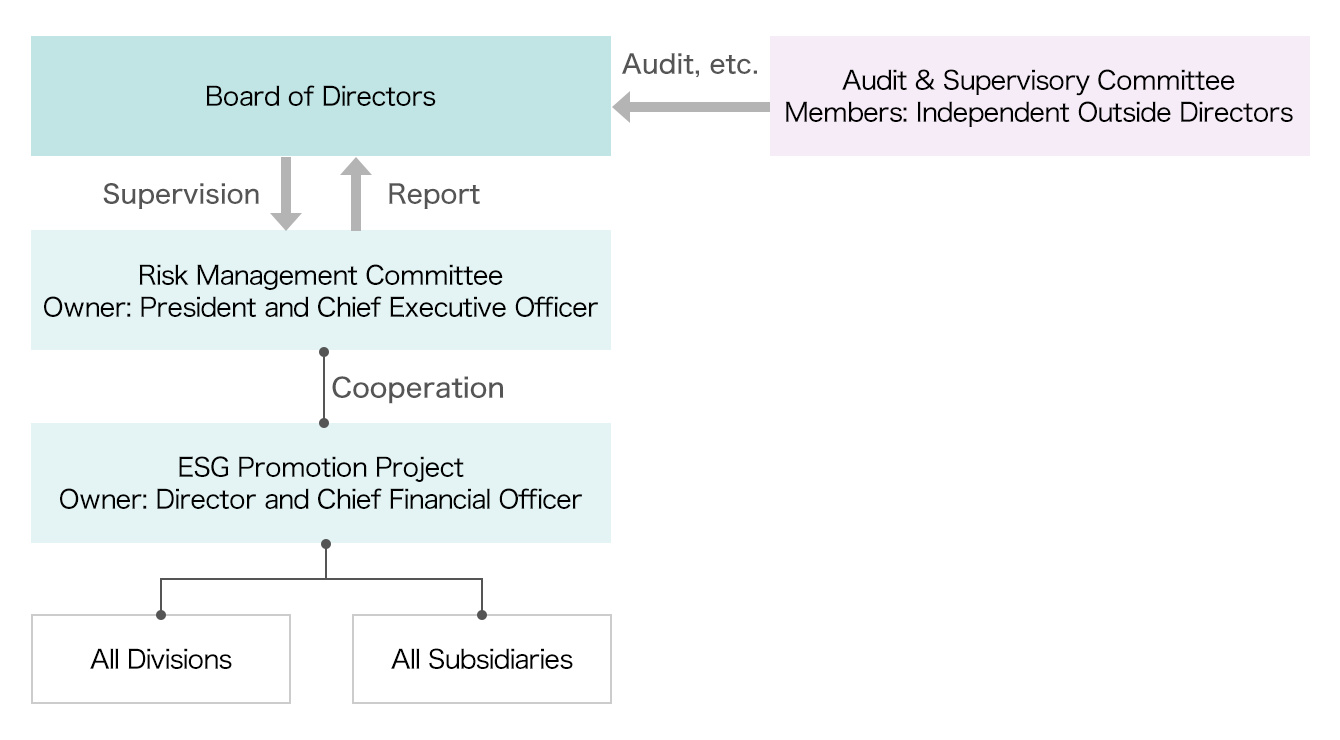TCFD
Governance
Basic Policy on Climate Change
We, the ValueCommerce Group (the Company and its subsidiaries), are committed to addressing issues surrounding climate change in order to achieve both a sustainable society and sustainable business growth for the ValueCommerce Group.
- We will develop and operate a company-wide system to address issues surrounding climate change.
- We will address climate change to the extent that is technologically and economically feasible, based on our understanding of the impact of our business activities on the climate.
- We will strive to reduce business risks associated with the effects of climate change while maximizing business opportunities.
- The Board of Directors will monitor the status of the ValueCommerce Group with regard to its climate change initiatives.
Governance System on Climate Change

The Group (including all consolidated subsidiaries) shall promote and implement climate change initiatives under an integrated risk management approach that takes ESG-related risks into full consideration.
At least once a year, the Board of Directors discusses how the Group will address climate change as an issue for sustainable growth, with regard to goals and the progression of the business.
The Audit & Supervisory Committee, which consists of independent outside directors, recognizes various issues related to climate change in the Group as risks and shall request reports from business divisions as appropriate.
The Risk Management Committee, which implements integrated risk management, is led by the President and Chief Executive Officer and meets at least four times a year to identify and assess risks, including climate change, for the Company and all consolidated subsidiaries. Each departmental manager in charge is responsible for responding to significant risks. In addition, the Risk Management Committee reports regularly to the Board of Directors on the status of the Company’s response to significant risks.
The ESG Promotion Project, which promotes ESG-related initiatives including climate change, is led by the Director and Chief Financial Officer and works with the Risk Management Committee, each division (corporate and business divisions), and each subsidiary to promote ESG-related measures.
Strategy
Process for identifying climate-related risks and opportunities
For each of our businesses, we identify physical risks, transition risks, and business opportunities related to climate change.
Scenario Analysis
We assess our business impact on the external environment for both the below 2°C and 4°C scenarios, and we continuously review our policies related to climate-related risks and opportunities. The external environment assumptions for the below 2°C and 4°C scenarios refer to external data such as multiple scenarios detailed in publications from the International Energy Agency (IEA) and the Intergovernmental Panel on Climate Change (IPCC).
Risks and Opportunities
| Classification of risks and opportunities based on TCFD recommendations | Risks and Opportunities for the Group | Business Impact Less than 2°C |
Business Impact 4°C |
|---|---|---|---|
| Policy and Regulation |
|
Medium | Small |
| Market |
|
Small | Small |
| Reputation |
|
Small | Small |
| Classification of risks and opportunities based on TCFD recommendations | Risks and Opportunities for the Group | Business Impact Less than 2°C |
Business Impact 4°C |
|---|---|---|---|
| Acute |
|
Minimal | Small |
| Chronic |
|
Minimal | Small |
| Classification of risks and opportunities based on TCFD recommendations | Risks and Opportunities for the Group | Business Impact Less than 2°C |
Business Impact 4°C |
|---|---|---|---|
| Labor practices |
|
Medium | Small |
| Products and Services |
|
Small | Minimal |
Risk Management
The Group shall promote and implement climate change initiatives under an integrated risk management approach that takes ESG-related risks into full consideration.
The Risk Management Committee, which implements integrated risk management, is led by the President and Chief Executive Officer and meets at least four times a year to identify and assess risks, including climate change, for the Company and all consolidated subsidiaries. Each departmental manager in charge is responsible for responding to significant risks. In addition, the Risk Management Committee reports regularly to the Board of Directors on the status of the Company’s response to significant risks.
The ESG Promotion Project, led by the Director and Chief Financial Officer, supports the activities of the Risk Management Committee (i.e. the identification and assessment of risks) with regard to climate change.
Metrics and Targets
Scope 1, Scope 2 and Scope 3 results
ESG data is disclosed on the Sustainability page. For more information, please click here (ESG data)
Climate-Related Targets and Achievements
Aim to achieve virtually zero GHG emissions (Scope 1+2) by FY2030.
| Unit | FY2023 | FY2024 | |
|---|---|---|---|
| GHG emissions (Scope 1+2) | t-CO₂ | 0 | 0 |